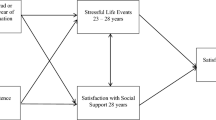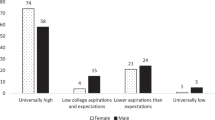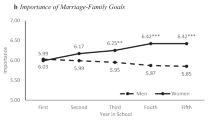This study investigated ethnic as well as gender and generational similarities and differences in the life goals among graduating high-school seniors. Adolescents came from six ethnic groups: White, African, Mexican, Other Latino, Filipino, and East/Southeast Asian Americans. Their self-articulated medium-range life goals were grouped into 8 major categories such as occupational, educational, familial, and material goals. Group differences in various aspects of future plans, such as priorities given to different life goals, time frame of attainment, and perceived controllability over their attainment, were also examined. Hypothesized group differences based on current social realities and small-scale qualitative studies on ethnic minorities were not found; there were very few ethnic, gender, and generational differences in adolescents’ life goals. All groups reported a higher priority for, earlier expected attainment of, and more control over their medium-range educational and occupational goals than their family-related and material goals. Further, long-term educational and occupational aspirations were high across all groups. There were moderate ethnic differences in educational expectations and none for corresponding career expectations. Thus, current inequalities in educational and occupational attainments across ethnic groups were only partially reflected in the life goals of adolescents on the brink of graduating from high school.

Similar content being viewed by others
REFERENCES
Arbona, C., and Novy, D. (1991). Career aspirations and expectations of Black, Mexican American, and White students. Career Dev. Q. 39: 231–239.
Barnett, V., and Lewis, T. (1994). Outliers in Statistical Data (3rd edn.). Wiley, New York.
Bluestone, B. (1970). The tripartite economy: Labor markets and the working poor. Poverty Hum. Res. Abstr. 5: 15–35.
Coleman, J. S., Campbell, E. Q., Hobson, C. J., McPartland, J., Mood, A. M., Weinfeld, F. D., York, R. L. (1966). Equality of Educational Opportunity. U.S. Government Printing Office, Washington, DC.
Cook, T., Church, M., Ajanaku, S., Shadish, W., Kim, J., and Cohen, R. (1996). The development of occupational aspirations and expectations among inner-city boys. Child Dev. 67: 3368–3385.
Csikszentmihalyi, M., and Schneider, B. (2000). Becoming Adult. Perseus, New York.
Cummins, J. (1986). Empowering minority students: A framework for intervention. Harv. Educ. Rev. 56: 18–36.
Eccles, J. (1994). Understanding women’s educational and occupational choices: Applying the Eccles et al. model of achievement-related choices. Psychol. Women Q. 18: 585–609.
Erikson, E. H. (1968). Identity: Youth and Crisis. Norton, New York.
Erikson, E. H. (1980). Identity and the Life Cycle. Norton, New York.
Eskilson, A., and Wiley, M. G. (1999). Solving for the X: Aspirations and expectations of college students. J. Youth Adolesc. 28: 51–70.
Fordham, S., and Ogbu, J. (1986). Black students’ school success: Coping with the “burden of acting White.” Urban Rev. 18: 176–206.
Fuligni, A. (1997). The academic achievement of adolescents from immigrant families: The roles of family background, attitudes, and behavior. Child Dev. 68: 351–363.
Fuligni, A. J., Tseng, V., and Lam, M. (1999). Attitudes toward family obligations among American adolescents with Asian, Latino American, and European backgrounds. Child Dev. 70: 1030–1044.
Heckhausen, J. (1997). Developmental regulation across adulthood: Primary and secondary control of age-related challenges. Dev. Psychol. 33: 176–187.
Heckhausen, J. (1999). Developmental Regulation in Adulthood: Age-Normative and Sociostructional Constraints as Adaptive Challenges. Cambridge University Press, New York.
Heckhausen, J., and Schulz, R. (1995). A life-span theory of control. Psychol. Rev. 102: 284–304.
Heckhausen, J., and Tomasik, M. J. (2002). Get an apprenticeship before school is out: How German adolescents adjust vocational aspirations when getting close to a developmental deadline. J. Vocat. Behav.: Special Issue on the Transition from School to Work: Societal Opportunities and Individual Agency 60: 199–219.
Howell, M., Frese, W., and Sollie, C. R. (1984). The measurement of perceived opportunity for occupational attainment. J. Vocat. Behav. 25: 325–343.
Kao, G. (2000). Group images and possible selves among adolescents: Linking stereotypes to expectations by race and ethnicity. Sociol. Forum 15: 407–430.
Kleinbaum, D. G., Kupper, L. L., Muller, K. E., and Nizam, A. (1998). Applied Regression Analysis and Other Multivariate Methods (3rd edn.). Brooks/Cole, London.
Kozol, J. (1991). Savage Inequalities: Children in America’s Schools. Crown, New York.
Majoribanks, K. (1998). Family background, social and academic capital, and adolescents’ aspirations: A mediational analysis. Soc. Psychol. Educ. 2: 177–197.
Malmberg, L.-E., and Norrgård, S. (1999). Adolescents’ ideas of normative life span development and personal future goals. J. Adolesc. 22: 33–47.
Mau, W.-C., and Bikos, L. H. (2000). Educational and vocational aspirations of minority and female students: A longitudinal study. J. Couns. Dev. 78: 186–194.
Myrdal, G. (1944). An American Dilemma: The Negro Problem and Modern Democracy. Harper and Row, New York.
Nakao, K., and Treas, J. (1994). Updating occupational prestige and socioeconomic status scores: How the new measures measure up. Sociol. Methodol. 24: 1–72.
National Center for Education Statistics (2001). Dropout Rates in the United States: 1999. NCES 2001–2022, Washington, DC.
Nurmi, J.-E. (1989). Development of orientation to the future during early adolescence: A four-year longitudinal study and two cross-sectional comparisons. Int. J. Psychol. 24: 195–214.
Nurmi, J.-E. (1991). How do adolescents see their future? A review of the development of future orientation and planning. Dev. Rev. 11: 1–59.
Nurmi, J.-E., Samelo-Aro, K., and Koivisto, P. (2002). Goal importance and related achievement beliefs and emotions during the transition from vocational school to work: Antecedents and consequences. J. Vocat. Behav. 60: 241–261.
Ogbu, J. (1994). From cultural differences to differences in cultural frame of reference. In Greenfield, P. M., and Codney, R. R. (eds.), Cross-Cultural Roots of Minority Child Development. Erlbaum, Hillsdale, NJ, pp. 365–391.
Phinney, J., Baumann, K., and Blanton, S. (2001). Life goals and attributions for expected outcomes among adolescents from five ethnic groups. Hisp. J. Behav. Sci. 23: 363–377.
Population Reference Bureau (2000, February). U.S. Occupational Segregation. Retrieved February 18, 2000 from http://www.prb.org/Template. cfm?Section=PRB&template=/Content-Management/ContentDisplay.cfm&ContentID x=7896.
Rumbaut, R. (1999). Passages to adulthood: The adaptation of children of immigrants in Southern California. In Hernandez, D. J. (ed.), Children of Immigrants: Health, Adjustment, and Public Assistance. National Academy Press, Washington, DC, pp. 478–541.
Rumbaut, R., and Cornelius, W. (1995). California’s Immigrant Children: Theory, Research, and Implications for Educational Policy. University of California, San Diego.
Schneider, B., and Stevenson, D (1999). The Ambitious Generation: America’s Teenagers, Motivated but Directionless. Yale University Press, New Haven, CT.
Solantus, T. (1987). Hopes and worries of young people in three European countries. Health Promot. 2: 19–27.
Steele, C. M., and Aronson, J. (1995). Stereotype threat and the intellectual test performance of African Americans. J. Pers. Soc. Psychol. 69: 797–811.
Steinberg, L., Lamborn, S. D., Dornbusch, S. M., and Darling, N. (1992). Impact of parenting practices on adolescent achievement: Authoritative parenting, school involvement, and encouragement to succeed. Child Dev. 63: 1266–1281.
Suárez-Orozco, M. (1989). Psychosocial aspects of achievement motivation among recent Hispanic immigrants. In Trueba, H. T., Spindler, G., and Spindler, L. (eds.), What do Anthropologists Have to Say About Dropouts?. Falmer, London, pp. 99–116.
Suárez-Orozco, M., and Suárez-Orozco, C. (1995). Cultural patterning of achievement motivation: A comparison of Mexican, Mexican immigrant, Mexican American, and non-Latino White American Students. In Rumbaut, R., and Cornelius, W. (eds.), California’s Immigrant Children: Theory, Research, and Implications for Educational Policy. University of California, San Diego.
U.S. Census Bureau (2002). The Big Payoff: Educational Attainment and Synthetic Estimates of Work-Life Earnings. U.S. Government Printing Office, Washington, DC.
Woodson, C. G. (1933). The Miseducation of the Negro. Amsterdam Press, New York.
Zhou, M., and Bankston, C. L. (2002). Appropriate gender roles in Vietnamese American families. In Benkokraitis, N. V. (ed.), Contemporary Ethnic Families in the United States: Characteristics, Variations, and Dynamics. Prentice-Hall, Englewood Cliffs, NJ.
Author information
Authors and Affiliations
Corresponding author
Additional information
This study was supported by the School of Social Ecology and the Department of Psychology and Social Behavior at the University of California, Irvine; as well as the Max-Planck-Award for International Cooperation granted to Jutta Heckhausen and funded by the German Federal Ministry of Education and Research (BMBF). We are indebted to Susan Farruggia, Ph.D. and Laura Gil-Trejo for their valuable contribution to data collection and help in the day-to-day management of the overall project. We also acknowledge with appreciation the assistance of numerous undergraduate research assistants in data collection and data entry.
Developmental psychologist with current interests in the familial factors that affect motivation and disengagement with life goals in adolescence and young adulthood
Developmental psychologist with current interests in cross-cultural human development,and the neural bases of math and language learning.
Developmental psychologist with clinical training. Her current interests are in the cross-cultural study of familial and peer factors in adolescents’ and young adults’ psychological well-being
Clinical psychologist with research interests in the links between economic stress and behavioral disorder
Developmental psychologist with a current focus on developmental regulation during major life-course transitions, in particular the transition from school to work and to college
Rights and permissions
About this article
Cite this article
Chang, E.S., Chen, C., Greenberger, E. et al. What Do They Want in Life?: The Life Goals of a Multi-Ethnic, Multi-Generational Sample of High School Seniors. J Youth Adolescence 35, 302–313 (2006). https://doi.org/10.1007/s10964-006-9034-9
Received:
Revised:
Accepted:
Published:
Issue Date:
DOI: https://doi.org/10.1007/s10964-006-9034-9




